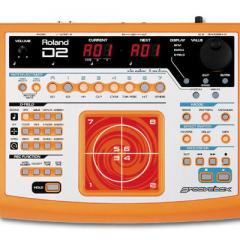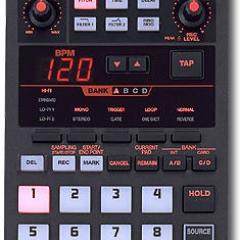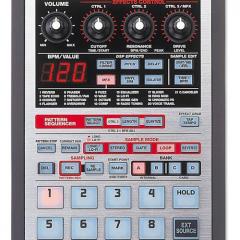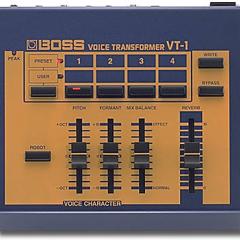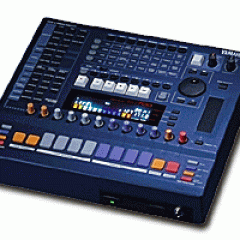Korg KAOSS Pad (KP1)
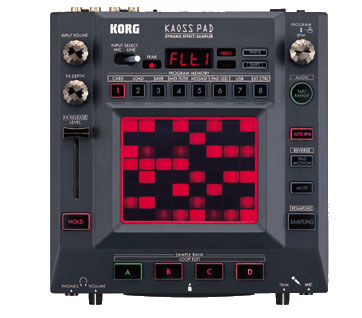
The KAOSS Pad 3 (or KP3 to 95% of the world) is a great little multi-feature device. It can sample, apply effects and offers some basic drum and synthesizer sounds. Some will say that none of these features are exceptionally good—and they're probably right. But, the strength of this device is its ability to be versatile and notably intuitive. By simply touching, tapping or sliding your finger over the large touchpad, you can control multiple effects parameters and manipulate samples in real time.
The sampling side of the KP3 is easy to figure out. Four samples (or phrases, because the KP3 is really of the 'phrase-sampler' ilk, rather than a traditional sampler) can be stored. The sampling time is 16 beats at 74 bpm—suggesting that the maximum sample time is about 13.2 seconds for each pad at 16-bit, 48kHz stereo. You can sample at 74 bpm or higher at beat values of 1, 2, 4, 8 or 16 per measure. Each sample can be a continuous loop or a one shot sample. Recording a sample is easily done by pressing "sampling" and then the pad you want to record to. It's that easy. The only draw back for some will be the fact that it only has RCA-style jacks for all incoming and outgoing audio.
Now the for best part: the effects! This section is incredibly intuitive because of the large centrally located X/Y touch pad. Effects are selected with a knob (there are 128 programs to choose from). The types of effects offered vary widely and can be used for a range of creative possibilities. From grain shifters, slicers, LFO modulation, echo, reverb, flanger, delay, filters to various combinations. Eight memory locations are provided above the touch pad to store your favorites, along with any pad motion recording, pad hold status and position, plus values for fx depth and fx release. Also, another attractive point of the KP3 is its ability to apply effects to the input of the unit, with or without samples playing back, effectively using it as a real-time effects processor. As this device begs to be used live, it does a great job at sampling the input or re-sampling the output on the fly. Another nice extra is the ability of the KP3 to provide a tap tempo and it has auto-BPM detection to beat-sync its tempo to the input (sometimes the sync is sloppy but you can help it by tapping the tap tempo button, indicating to the KP3 where the beat is). This tempo can be output in MIDI to clock other devices, as well as any button you push or activity on the touch pad can transmit/receive MIDI for the option to record and playback your performances in a sequencer.
Another interesting thing is, for the first time, the KP3 can save all its memory to an SD card. You can't name the samples, they are numbered from 00 to 99. You can also save all the data (the 8 effects locations, samples, global settings) into 1 of 10 possible memory locations on the SD card. All of this information can also be created or edited via the included KP3 editor/librarian software via USB connection to your computer.
Whether you are in a studio, live, a pro or not, the KP3 begs to shape, re-shape, bend and loop your music in an immediate and intuitive way.
The KP3 was preceded by two earlier generations:
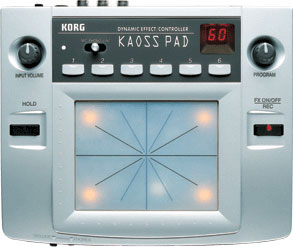
Korg KAOSS Pad 1
Originally released in 1999, the KP1 featured up to 6 available effects at a time (instead of 8 on the newer models) and lacked any sampling ability or basic synth tones. It was, for all intents and purposes, a DJ-oriented, real-time effects processor and MIDI-controller with an immediate hands-on or touch-style approach, a super simple layout and lots of cool lights!
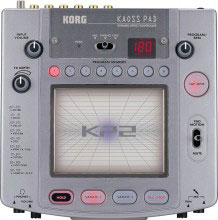
Korg KAOSS Pad 2
2002 brought the KP2 which added a phrase-sampler with 12 seconds of 44.1kHz sampling and synth and drum sounds derived from the ElecTribe series. Memory, I/O and even the touch-pad all received upgrades from the original unit as well.
Demos & Media
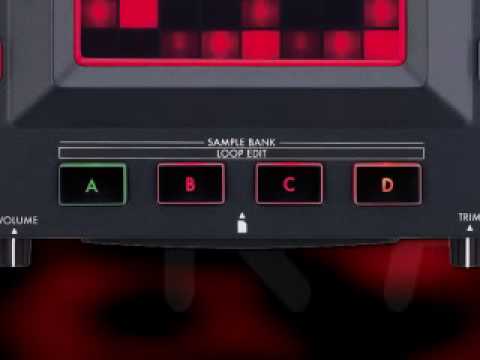
Specifications
Up to 8 beats X 4 pads at tempos of 72 BPM and lower.
100 samples maximum when using SD card.
Filter
Isolator & Distortion
Talk-Filter
Flanger
8-band EQ
Mid Pitch Shifter
Broken Modulation
Phaser
Ring Modulator & High-pass Filter
Decimator
Low Compressor
Auto-Pan
Slicer
Delay (Ping-Pong, Multi-tap, Reverse & High-pass Filter)
Tape Echo
Reverb
Gate Reverb
Grain Shifter
Vinyl Looper
Looper Forward / Reverse
Four-Sample-Bank Cross Fader Roll
Pad Drum1 / 2
Unison Saw Bass
Noise Synthesizer & Looper
Vocoder
Vocoder M7
